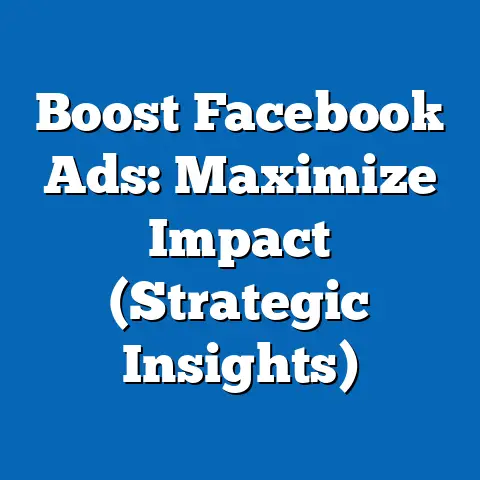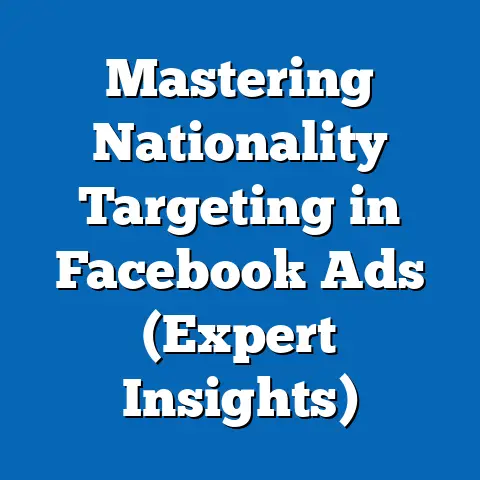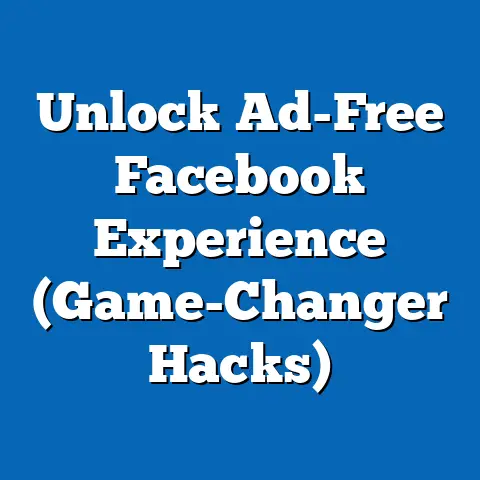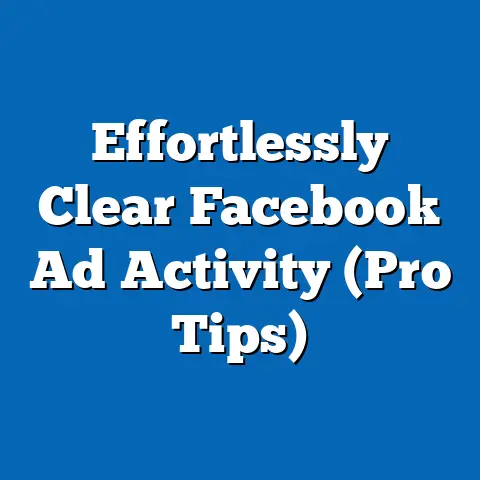Maximize ROI with Facebook Ad Automation (Smart Strategies)
The world of digital marketing can feel like a constant tightrope walk, especially when it comes to Facebook ads. We all want to reach our ideal customers, but the fear of burning through our budget without seeing results is a real concern. As a digital marketer, I’ve felt that pressure firsthand, trying to balance reach with affordability. The good news is, Facebook Ad Automation offers a powerful solution, allowing businesses of all sizes to not only save time but also significantly boost their return on investment (ROI) – and that’s what I’m going to delve into in this article.
Facebook Ad Automation isn’t just about setting and forgetting; it’s about strategically leveraging Facebook’s tools to make your campaigns smarter, more efficient, and ultimately, more affordable. I’ll walk you through understanding the core concepts, implementing smart strategies, measuring success, and even share real-world examples of businesses that have cracked the code. By the end of this guide, you’ll be equipped with the knowledge and confidence to transform your Facebook ad campaigns and achieve affordable success.
Understanding Facebook Ad Automation
Facebook Ad Automation, at its core, is about using Facebook’s built-in tools and features to manage and optimize your ad campaigns with minimal manual effort. Think of it as having a team of virtual assistants constantly monitoring your ads, making adjustments based on pre-set rules and algorithms. This is incredibly relevant in today’s fast-paced digital marketing landscape, where staying ahead of the curve requires agility and the ability to adapt quickly.
Facebook provides a variety of tools for automating ads. Let’s look at some of the most important ones:
- Automated Rules: These let you set specific conditions and actions that Facebook will automatically execute. For example, you can set a rule to pause an ad if its cost per result exceeds a certain amount, or to increase the budget of an ad set that’s performing exceptionally well.
- Campaign Budget Optimization (CBO): With CBO, you set a budget at the campaign level, and Facebook automatically distributes it across your ad sets based on which ones are delivering the best results. This eliminates the guesswork of manually allocating budget to each ad set.
- Dynamic Creative: This feature allows you to upload multiple versions of your ad creative (images, videos, headlines, descriptions, and calls to action), and Facebook automatically tests different combinations to find the ones that resonate best with your audience.
The benefits of automation are clear. It streamlines ad management, reduces manual tasks, and minimizes the risk of human error. Instead of spending hours poring over reports and making manual adjustments, you can focus on higher-level strategic tasks, like developing compelling ad copy and identifying new target audiences.
But perhaps the most significant advantage of Facebook Ad Automation is its ability to leverage algorithms to optimize ad placements and targeting. Facebook’s algorithms are incredibly sophisticated, constantly learning and adapting to user behavior. By automating your campaigns, you’re essentially putting these algorithms to work for you, ensuring that your ads are shown to the right people at the right time, maximizing your ROI and making your campaigns more affordable.
Key Takeaway: Facebook Ad Automation is about using Facebook’s tools to streamline your ad management, reduce manual tasks, and leverage algorithms for better ad placements and targeting, ultimately leading to more affordable campaigns.
Smart Strategies for Implementing Facebook Ad Automation
Now that we understand what Facebook Ad Automation is, let’s dive into some smart strategies for implementing it effectively. The key here is to be strategic and intentional, not just blindly automating everything.
Setting Clear Objectives
Before you even touch a single setting in Facebook Ads Manager, you need to define clear, measurable objectives for your ad campaigns. What exactly do you want to achieve? Are you looking to:
- Increase brand awareness?
- Drive traffic to your website?
- Generate leads?
- Boost sales?
Your objectives will dictate the type of campaign you run, the metrics you track, and the automation strategies you implement. For example, if your goal is to generate leads, you’ll want to focus on metrics like cost per lead (CPL) and conversion rates, and you might set up automated rules to pause ads with a high CPL.
Automating based on specific goals leads to more focused and cost-effective ads. Instead of wasting money on broad, unfocused campaigns, you’re directing your resources towards activities that are directly aligned with your objectives. This is where the “smart” in “smart strategies” comes into play.
Utilizing Automated Rules
Automated Rules are one of the most powerful tools in the Facebook Ad Automation arsenal. They allow you to set specific conditions and actions that Facebook will automatically execute, based on the performance of your ads.
Here’s how it works:
- Define a Condition: This is the trigger that will initiate the action. Examples include:
- Cost per result exceeding a certain amount
- Click-through rate falling below a certain percentage
- Ad spend reaching a certain limit
- Define an Action: This is what Facebook will do when the condition is met. Examples include:
- Pausing the ad
- Increasing the budget
- Sending a notification
- Adjusting the bid
- Cost per result exceeding a certain amount
- Click-through rate falling below a certain percentage
- Ad spend reaching a certain limit
- Pausing the ad
- Increasing the budget
- Sending a notification
- Adjusting the bid
Let’s look at some examples of successful implementations of automated rules that have maximized ROI:
-
Example 1: Pausing Underperforming Ads
- Condition: Cost per purchase is greater than $20.
- Action: Pause the ad.
- Rationale: This rule prevents you from wasting money on ads that aren’t generating sales efficiently.
-
Example 2: Increasing Budget for High-Performing Ads
- Condition: Ad set’s return on ad spend (ROAS) is greater than 3.
- Action: Increase the daily budget by 20%.
- Rationale: This rule allows you to capitalize on ads that are generating a high return on investment.
-
Example 3: Adjusting Bids Based on Performance
- Condition: Ad’s click-through rate (CTR) is below 1%.
- Action: Decrease the bid by 10%.
- Rationale: This rule helps you optimize your bidding strategy to ensure that you’re not overpaying for clicks.
Example 1: Pausing Underperforming Ads
- Condition: Cost per purchase is greater than $20.
- Action: Pause the ad.
- Rationale: This rule prevents you from wasting money on ads that aren’t generating sales efficiently.
Example 2: Increasing Budget for High-Performing Ads
- Condition: Ad set’s return on ad spend (ROAS) is greater than 3.
- Action: Increase the daily budget by 20%.
- Rationale: This rule allows you to capitalize on ads that are generating a high return on investment.
Example 3: Adjusting Bids Based on Performance
- Condition: Ad’s click-through rate (CTR) is below 1%.
- Action: Decrease the bid by 10%.
- Rationale: This rule helps you optimize your bidding strategy to ensure that you’re not overpaying for clicks.
These are just a few examples, but the possibilities are endless. The key is to think strategically about what metrics are most important to you and set up rules that will help you optimize those metrics.
Implementing Campaign Budget Optimization (CBO)
Campaign Budget Optimization (CBO) is a feature that allows Facebook to automatically distribute your budget across different ad sets within a campaign. Instead of manually setting a budget for each ad set, you set a single budget at the campaign level, and Facebook’s algorithm allocates the budget to the ad sets that are delivering the best results.
This can be a game-changer for affordability, as it ensures that your budget is always being used in the most efficient way possible. However, effective CBO management requires a strategic approach.
Here are some tips for managing CBO effectively:
- Initial Budget Setting: Start with a budget that’s appropriate for your target audience and campaign objectives. Don’t start too low, as this may not give the algorithm enough data to work with.
- Performance Monitoring: Regularly monitor the performance of your ad sets to see how the budget is being allocated. If you notice that certain ad sets are consistently underperforming, you may need to adjust your targeting or creative.
- Ad Set Structure: Ensure that your ad sets are structured in a way that allows Facebook to effectively compare their performance. For example, you might create separate ad sets for different target audiences or placements.
- Patience: Give the algorithm time to learn and optimize your campaign. It may take a few days or even weeks to see the full benefits of CBO.
From my experience, CBO works best when you have a well-defined campaign structure and clear objectives. It’s not a magic bullet, but it can be a powerful tool for optimizing your budget and maximizing your ROI.
Leveraging Dynamic Creative
Dynamic Creative is a feature that allows you to upload multiple versions of your ad creative (images, videos, headlines, descriptions, and calls to action), and Facebook automatically tests different combinations to find the ones that resonate best with your audience.
This can lead to better engagement rates and lower costs per action (CPA) because you’re essentially letting Facebook’s algorithm do the work of A/B testing for you.
Here’s how Dynamic Creative works:
- Upload Multiple Assets: Upload multiple versions of your images, videos, headlines, descriptions, and calls to action.
- Let Facebook Test: Facebook will automatically test different combinations of these assets to see which ones perform best.
- Optimize Based on Results: Facebook will prioritize the combinations that are generating the best results, ensuring that your ads are always being shown with the most effective creative.
Dynamic Creative is particularly useful for:
- Testing Different Messaging: You can test different headlines and descriptions to see which ones resonate best with your audience.
- Finding the Right Visuals: You can test different images and videos to see which ones grab attention and drive engagement.
- Optimizing Calls to Action: You can test different calls to action to see which ones encourage people to take the desired action.
Key Takeaway: Implementing smart strategies like setting clear objectives, utilizing automated rules, implementing CBO, and leveraging dynamic creative can significantly improve the affordability and effectiveness of your Facebook ad campaigns.
Measuring Success and Adjusting Strategies
Implementing Facebook Ad Automation is only half the battle. The other half is measuring your success and adjusting your strategies based on the data you collect. Without proper tracking and analysis, you’re essentially flying blind.
Tracking key performance indicators (KPIs) is crucial for assessing the effectiveness of your automated campaigns. These KPIs will vary depending on your campaign objectives, but some common ones include:
- Conversion Rate: The percentage of people who take the desired action (e.g., making a purchase, filling out a form).
- Cost Per Conversion: The amount you spend to generate one conversion.
- Return on Ad Spend (ROAS): The amount of revenue you generate for every dollar you spend on ads.
- Click-Through Rate (CTR): The percentage of people who click on your ad.
- Cost Per Click (CPC): The amount you spend for each click on your ad.
Facebook Ads Manager provides a wealth of data that can help you evaluate ROI. You can track these metrics at the campaign, ad set, and ad level, allowing you to identify areas where you’re succeeding and areas where you need to improve.
Interpreting the data you collect is essential for making informed decisions about your ad strategies and budget allocation. For example, if you notice that your cost per conversion is high, you might need to adjust your targeting, creative, or bidding strategy. If you see that your click-through rate is low, you might need to improve your ad copy or visuals.
A/B testing is another valuable tool for improving ad performance and affordability. By testing different variations of your ads, you can identify what works best and optimize your campaigns accordingly.
For example, you could A/B test different headlines, images, or calls to action to see which ones generate the best results. You can also A/B test different targeting options to see which audiences are most responsive to your ads.
Key Takeaway: Measuring success and adjusting strategies based on data is crucial for maximizing ROI with Facebook Ad Automation. Track KPIs, interpret data, and use A/B testing to continuously improve your ad performance.
Real-World Case Studies
Let’s take a look at some real-world examples of businesses that have successfully implemented Facebook Ad Automation to maximize ROI.
Case Study 1: E-commerce Business
- Challenge: This e-commerce business was struggling to generate sales efficiently with their Facebook ads. They were spending a lot of money, but their return on ad spend (ROAS) was low.
- Solution: They implemented Facebook Ad Automation by:
- Setting up automated rules to pause underperforming ads.
- Implementing Campaign Budget Optimization (CBO) to allocate budget to the best-performing ad sets.
- Leveraging Dynamic Creative to test different ad variations.
- Results:
- ROAS increased by 50%.
- Cost per purchase decreased by 30%.
- Overall ad spend decreased by 20%.
- Setting up automated rules to pause underperforming ads.
- Implementing Campaign Budget Optimization (CBO) to allocate budget to the best-performing ad sets.
- Leveraging Dynamic Creative to test different ad variations.
- ROAS increased by 50%.
- Cost per purchase decreased by 30%.
- Overall ad spend decreased by 20%.
Case Study 2: Local Service Provider
- Challenge: This local service provider was having trouble generating leads with their Facebook ads. Their cost per lead (CPL) was high, and they weren’t getting enough qualified leads.
- Solution: They implemented Facebook Ad Automation by:
- Setting up automated rules to adjust bids based on performance.
- Using Dynamic Creative to test different ad copy and visuals.
- Targeting specific demographics and interests with their ads.
- Results:
- CPL decreased by 40%.
- Lead quality improved significantly.
- Overall ad spend remained the same, but their ROI increased dramatically.
- Setting up automated rules to adjust bids based on performance.
- Using Dynamic Creative to test different ad copy and visuals.
- Targeting specific demographics and interests with their ads.
- CPL decreased by 40%.
- Lead quality improved significantly.
- Overall ad spend remained the same, but their ROI increased dramatically.
These case studies illustrate the impact of automation on affordability and overall campaign success. By strategically implementing Facebook Ad Automation, these businesses were able to improve their ROI, reduce their costs, and achieve their marketing objectives.
Key Takeaway: Real-world case studies demonstrate that Facebook Ad Automation can significantly improve ROI and reduce costs for businesses of all sizes.
Conclusion
In conclusion, Facebook Ad Automation offers a powerful solution for businesses looking to maximize their ROI and achieve affordable success in their advertising efforts. By understanding the core concepts, implementing smart strategies, measuring success, and adjusting your approach based on data, you can transform your Facebook ad campaigns and achieve your marketing objectives.
Remember, Facebook Ad Automation isn’t about setting and forgetting. It’s about strategically leveraging Facebook’s tools to make your campaigns smarter, more efficient, and ultimately, more affordable. With the right strategies, businesses can achieve affordable success in their advertising efforts.
I encourage you to consider automation as a viable option for enhancing your Facebook ad campaigns and improving your overall marketing efficiency. It’s a journey of continuous learning and optimization, but the rewards are well worth the effort. So, dive in, experiment, and see how Facebook Ad Automation can help you achieve your goals.






